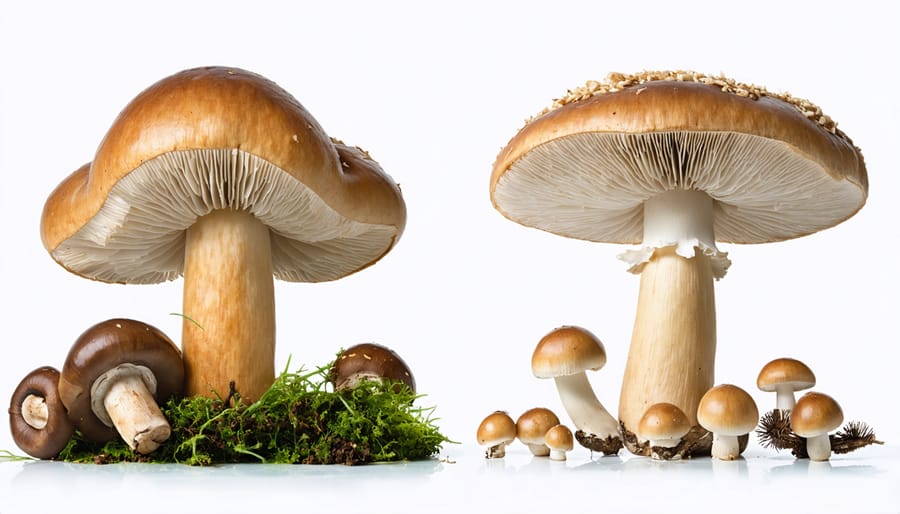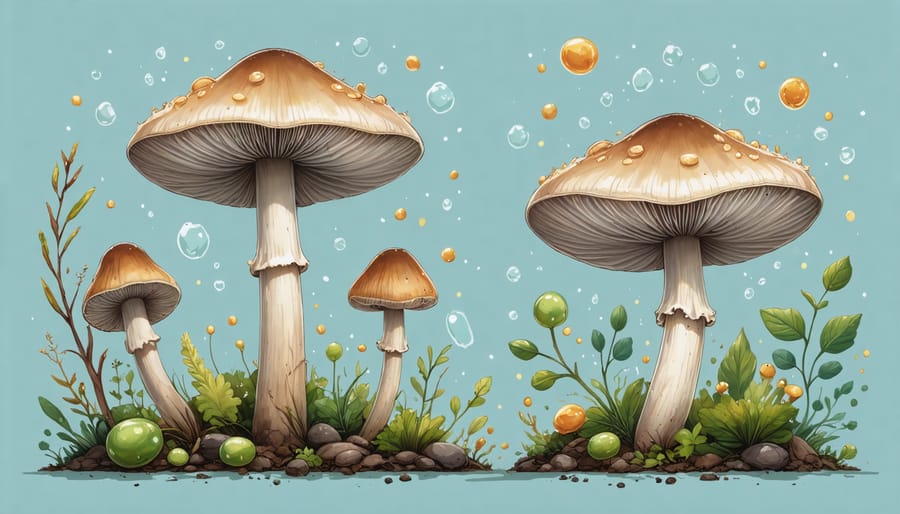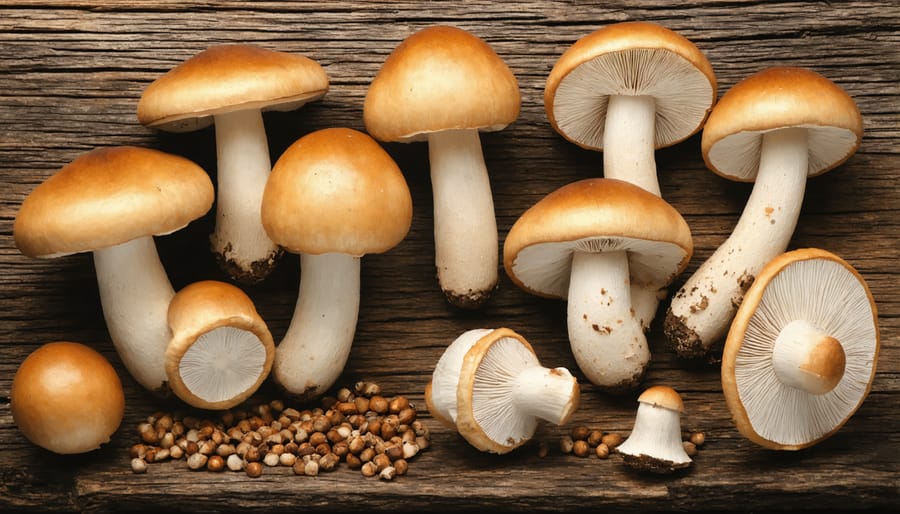
The aroma of sautéed mushrooms might make your mouth water, but that lingering question about fungal infections can dampen even the most enthusiastic foodie’s appetite. Let me put your mind at ease: eating properly prepared mushrooms from reliable sources does not cause fungal infections. As someone who’s spent years exploring both the culinary and health aspects of mushrooms, I can confidently say that the connection between eating mushrooms and developing fungal infections is largely a misconception that needs clearing up.
The truth is, edible mushrooms are not only safe but pack impressive health benefits – from immune system support to providing essential nutrients. While it’s true that some mushrooms can cause adverse reactions if misidentified or improperly prepared, store-bought varieties and those harvested by expert foragers pose no risk of fungal infections. The cooking process itself eliminates any potential concerns, as heat destroys most problematic compounds that could cause digestive issues.
This friendly guide will help you understand why this common worry is unfounded and how to safely enjoy these versatile fungi in your daily meals.
The Science Behind Mushrooms and Your Body
How Your Body Processes Mushrooms
Let me put your mind at ease about how your body handles those delicious mushrooms you enjoy in your meals. When you eat mushrooms, they go through the same digestive process as other foods – they’re broken down by your stomach acid and digestive enzymes into simple nutrients your body can use.
Think of your digestive system as a highly efficient processing plant. The mushrooms you eat are essentially deactivated in your stomach’s acidic environment, which means they can’t grow or spread inside your body. It’s similar to how we can safely eat yogurt without the beneficial bacteria taking over our system!
Your body is incredibly smart about processing different foods, and mushrooms are no exception. The complex proteins and fibers in mushrooms are broken down into amino acids and other beneficial compounds that actually support your immune system. In fact, many edible mushrooms contain compounds that can help fight off harmful organisms – talk about a plot twist!
So next time you’re enjoying your favorite mushroom dish, remember that your digestive system knows exactly what to do with those fungi, turning them into valuable nutrition rather than unwanted visitors.
The Difference Between Edible Fungi and Harmful Fungi
Let me put your mind at ease – the mushrooms you enjoy in your salads and stir-fries are completely different from the fungi that cause infections. Think of it like comparing apples to oranges – they might both be fruits, but they’re entirely different! Edible mushrooms, like portobello, shiitake, and button mushrooms, are carefully cultivated and selected specifically for human consumption. They’ve been part of our diets for thousands of years and are packed with nutrients.
The fungi that cause infections, on the other hand, are microscopic organisms that operate in a totally different way. While both are technically fungi, they’re as different as a house cat and a lion – same family, but very different creatures! The harmful fungi typically spread through direct contact, contaminated surfaces, or sometimes through the air, but not through eating properly prepared culinary mushrooms.
I remember being concerned about this myself when I first started exploring mushroom recipes, but learning about these differences helped me embrace these delicious and nutritious ingredients with confidence.

Health Benefits of Eating Mushrooms
Immune System Warriors
Here’s something fascinating about mushrooms that might surprise you – they’re actually immune system superheroes! While some people worry about mushrooms causing infections, these fantastic fungi are working hard to boost your immune system naturally.
Let me tell you about beta-glucans, the real stars of the show. These powerful compounds found in mushrooms are like personal trainers for your immune cells, teaching them to work more effectively. I remember being amazed when I first learned that these natural substances could actually help our bodies become stronger from the inside out!
But beta-glucans aren’t working alone. Mushrooms are packed with other immune-strengthening compounds like polysaccharides and antioxidants. Together, they create a wellness dream team that supports your body’s natural defense mechanisms. Think of them as your internal security system, constantly working to keep you healthy and protected.
The really exciting part? Different mushroom varieties offer their own unique immune-boosting benefits. Whether you’re enjoying shiitake in your stir-fry or adding some cremini to your pasta sauce, you’re not just making a delicious meal – you’re giving your immune system some serious backup. It’s like having an army of tiny defenders working around the clock to keep you feeling your best!

Beyond Immunity: Additional Health Perks
While we’ve addressed the safety of mushrooms, let’s explore their incredible health benefits that make them truly worth adding to your plate. As someone who discovered these perks during my own wellness journey, I’m excited to share how mushrooms can be your allies in maintaining optimal health.
First up is vitamin D – a nutrient many of us struggle to get enough of. Mushrooms are one of the few natural food sources of this sunshine vitamin, especially when they’re exposed to UV light during growth. I love incorporating them into my winter meals when sunlight is scarce!
The antioxidant content in mushrooms is another game-changer. These powerful compounds help protect your cells from damage and support overall wellness. Different varieties offer unique antioxidant profiles – for instance, shiitake mushrooms are particularly rich in compounds that support heart health.
When it comes to minerals, mushrooms are like nature’s multivitamin. They’re packed with selenium, copper, and potassium, which support everything from thyroid function to energy production. Taking a mindful approach to eating these nutritional powerhouses can help you maximize their benefits.
Remember, these health perks come alongside mushrooms’ unique umami flavor and versatility in cooking. Whether you’re sautéing them for breakfast or adding them to your favorite stir-fry, you’re not just enjoying a delicious meal – you’re nourishing your body in multiple ways.
Safe Mushroom Consumption Tips

Shopping Smart: Selecting Fresh Mushrooms
I’ll never forget my first time shopping for mushrooms at a local farmers’ market – the vendor shared some invaluable tips that I still use today! When selecting fresh mushrooms, look for ones that are firm, plump, and have a fresh, earthy smell. They should be free from dark spots, slime, or any signs of decay.
The best mushrooms have a uniform color appropriate to their variety, whether that’s the classic white button mushrooms or rich brown creminis. Avoid any that appear wrinkled, dried out, or have excessive moisture. A quick tip I learned: if the gills are extremely dark or showing signs of deterioration, it’s best to pass.
Store your mushrooms in a paper bag in the refrigerator – this allows them to breathe while maintaining the right moisture level. Avoid plastic bags, which can trap moisture and speed up spoilage. Clean them only when you’re ready to use them, as washing too early can make them spoil faster.
Trust your instincts when shopping – if something doesn’t look or smell quite right, it probably isn’t. Fresh mushrooms should feel light but firm, with no sticky residue or unusual odors. These simple guidelines will help ensure you’re getting the safest, most delicious mushrooms for your meals.
Kitchen Safety: Proper Storage and Preparation
Just like any fresh produce, proper storage and handling of mushrooms is crucial for both safety and flavor. I learned this the hard way after once finding a forgotten container of mushrooms turned to mush in my fridge! Now, I always follow safe food preparation practices to keep my mushrooms fresh and healthy.
Store your mushrooms in a paper bag or their original packaging in the refrigerator, avoiding plastic bags which can trap moisture and speed up spoilage. Before using them, give them a quick inspection – they should be firm, dry, and free from dark spots or slime. A light cleaning with a soft brush or paper towel is all you need; avoid soaking them in water as mushrooms are like tiny sponges!
When it comes to cooking, always use clean cutting boards and utensils. Make sure to cook mushrooms thoroughly – not only does this enhance their flavor, but it also eliminates any potential harmful microorganisms. For optimal results, cook them at medium-high heat until they release their moisture and become golden brown. This brings out their natural umami flavor while ensuring they’re safe to eat.
Remember to consume stored mushrooms within a week, and if you notice any signs of spoilage, it’s better to be safe and discard them.
When to Be Cautious
While mushrooms are generally safe to eat, there are certain situations where you’ll want to be extra mindful about your mushroom consumption. If you’re immunocompromised, recovering from a serious illness, or undergoing treatments that affect your immune system, it’s wise to consult with your healthcare provider about including mushrooms in your diet.
I remember chatting with my friend Sarah, who was going through chemotherapy, and her doctor had specific guidelines about when and how she could enjoy mushrooms during her treatment. These conversations reminded me that what’s perfectly safe for most of us might need more consideration for others.
Pregnant women should also exercise additional caution, particularly with raw mushrooms or wild-foraged varieties. While store-bought mushrooms are typically fine when properly cooked, it’s always better to err on the side of caution during pregnancy.
Those with existing fungal infections or a history of recurring fungal issues might want to temporarily limit mushroom consumption while working with their healthcare provider to address these concerns. The same goes for anyone taking antifungal medications – it’s worth having a quick chat with your doctor about timing your mushroom consumption appropriately.
Remember, these precautions don’t mean you need to avoid mushrooms entirely – they’re just situations where a bit of extra care goes a long way in ensuring your wellbeing.
Rest assured, enjoying mushrooms as part of your diet is perfectly safe when you follow proper sourcing and preparation guidelines. The idea that eating mushrooms can lead to fungal infections is largely a misconception – your digestive system is well-equipped to process edible mushrooms without any risk of developing internal fungal growth. By purchasing mushrooms from reliable sources, storing them correctly, and cooking them thoroughly, you’re not only protecting yourself but also unlocking their amazing nutritional benefits. Remember, mushrooms have been a treasured part of human cuisine for thousands of years, offering unique flavors and health-boosting properties. So go ahead and embrace these fantastic fungi in your cooking – they’re a safe, delicious, and nutritious addition to any meal when handled with care.



